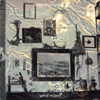 First released in 1986 on Torso, this enduringly bizarre collage of kaleidoscopic surrealism has now been reissued with the original cover art. More than two decades later, it still stands as one of the clear highlights of Stephen Stapleton’s singularly daunting and mountainous discography.
First released in 1986 on Torso, this enduringly bizarre collage of kaleidoscopic surrealism has now been reissued with the original cover art. More than two decades later, it still stands as one of the clear highlights of Stephen Stapleton’s singularly daunting and mountainous discography.
Spiral Insana is a series of 20 abruptly starting and stopping musical interludes which are comically and unhelpfully presented in just three tracks, which makes it an almost hopeless endeavor to determine exactly which piece is playing at a given time without a pen and a lengthy attention span. Despite the demented and sprawling nature of the material covered here, there are many recurring sounds and themes strewn throughout the album, which makes me feel like it might be a musical analogue to Raymond Queneau’s Exercises In Style (which describes the same incident 99 times with wildly differing tone). Of course, sometimes it all sounds completely random too. I suspect only Stephen Stapleton knows if there is a coherent theme linking the various components of this song suite together. Two of the "songs" included here were not on the original album ("Mourning Smile" and "Ship of the Dead"), but have been present since the 1997 United Dairies reissue. They fit seamlessly into the surrounding material, so I suspect they are belated enhancements rather than mere bonus tracks. Not that it matters, though- it is a wild and compelling ride regardless of its theoretical foundations (or lack thereof).
Spiral Insana opens (with "Sea Armchair") in characteristically unmusical NWW fashion with some arrhythmic scraping metal sounds, but then something very unexpected happens: the metal is overpowered by a haunting and warm (almost ambient) synth progression and a weirdly reggae-influenced, yet martial, rhythmic clanging. Then it all jarringly cuts out and it is clear that I am, in fact, listening to Nurse With Wound and not an Angelo Badalamenti album. Oddly, that same synth progression immediately starts up again, only this time the metallic sounds are replaced by manipulated feedback and gradually intensifying amplifier hum…followed by yet another violent cut. Now shuffling jazz drums slink out of the speakers, but are quickly bludgeoned to death by very loud, mangled, and heavily tweaked pipe organ samples. Another jarring cut (and so on…ad infinitum).
The interludes seem to grow weirder and darker and less interrelated as the album progresses, which gives the album a disquieting arc (as if it is all spewing forth from an increasingly desperate and disjointed mind). Many of the varied interludes are noisy, fragmented, and somewhat abrasive, but there is always a playful sense of mischief lurking in the shadows, ready to blunder into the steadily darkening fever dream at any second. Feedback, distorted looping amp hum, metallic noises, blaring pipe organs, treated voices, and the beautiful opening synth progression are all recurrent motifs, but they are regularly disrupted by all manner of surrealist mindfuckery: duck noises, discordant flute pile-ups, a mournful and heavily reverbed French horn, a lonely oboe, tribal percussion that sounds like it is being played on a bucket, roosters, kazoos, and field recordings of birds all make brief and unexpected appearances. I was especially (and pleasantly) startled by a very jaunty honky tonk piano interlude, an elegiac bagpipe procession, and the distant and heavily reverbed female vocalist that closes the album with solemn dignity (although it sounds like she is being assisted by an particularly unhappy dinosaur at times). In fact, that closing piece ("Nihil") may be one of the most beautiful and nuanced works in the entire NWW catalog.
It is never easy to tell how much influence collaborators have in shaping what a finished Nurse With Wound album sounds like, but it seems likely that Spiral Insana owes at least some of its density, fractured lunacy, and surprising musicality to the handful of talented contributors involved. The liner notes shed very little light on this, although they unhelpfully specify that David Jackman (Organum) contributed “splutter" (it remains a mystery whether Mr. Jackman's spluttering and banjo playing were instrumental in the formation of the album or merely source material for Stapleton to incorporate into a fully-formed vision). Also, I expected the backbone ambient synthesizer theme to be the work of Sema’s Robert Haigh, but he is only credited with guitar, so all bets are off (I have perhaps grossly underestimated Stapleton’s technical abilities as a multi-instrumentalist). Regardless of the actual mechanics involved, this is a brilliantly skewed and excellent album that has not faded with age one bit.
samples:
Read More

